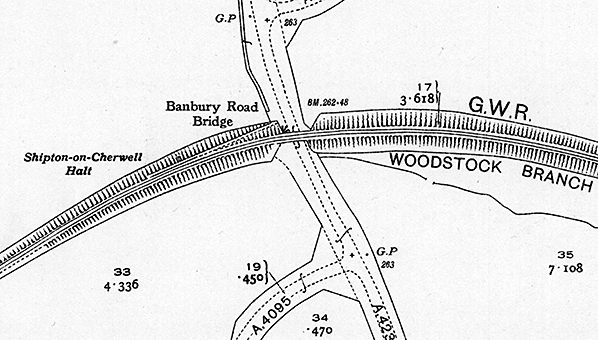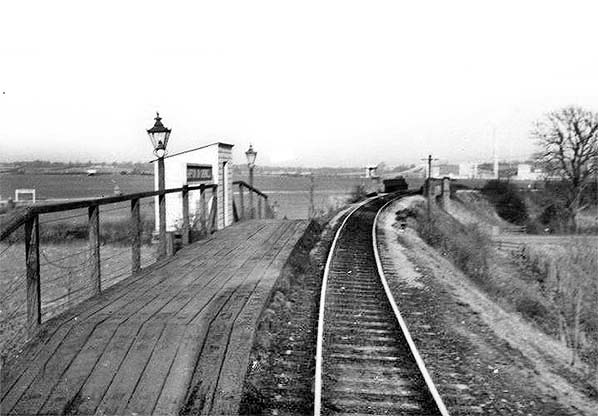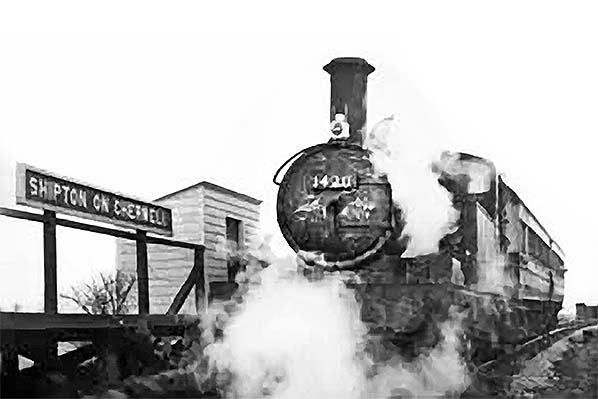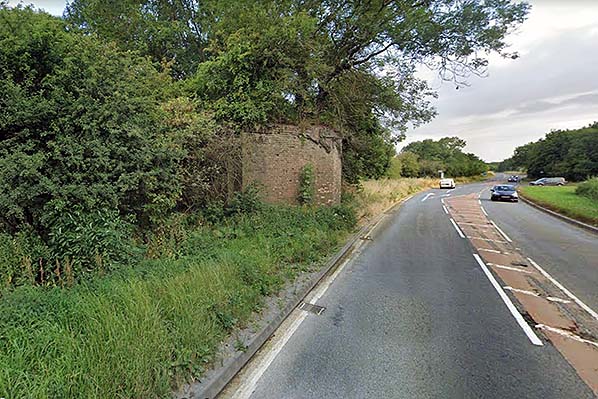
Station Name: SHIPTON-ON-CHERWELL HALT[Source: Nick Catford]
halt_old6.jpg) Looking north at Shipton-on-Cherwell Halt from the A4095 c1930s, after the platform height was increased.
Copyright photo from John Alsop collection  
1938 1:2,500 OS map. The path up the side of the embankment from the road is clearly seen as is the short platform edge, opposite the waiting shelter,

Looking east along the platform at Shipton-on-Cherwell Halt c1950. Shipton-on-Cherwell cement works are seen in the distance.
Photo from John Mann collection )halt_old7.jpg) The3 basic but adequate facilities are seen in this view of Shipton in Cherwell Halt c1950s. The bridge visible, seen right background, carried the line over the Oxford - Banbury road and at one time the bridge sat in the middle of what was a four-way road junction. At some point in time, perhaps in the 1930s, the road layout was altered into the form of two 'T' junctions situated some 150 yards apart with one north of the bridge and one south thereof. One can imagine this change was made for road safety reasons as motor vehicles became increasing common.
Photo from John Mann collection halt_old5.jpg)
Entrance to the platform was through a kissing gate and along a footpath up the embankment. A large sign notifies the potential passengers for the halt. The cast iron trespass sign is still there and it is believed the kissing gate is also still there albeit heavily overgrown.
Photo by RC Riley halt_old4.jpg)
A single passenger waits for a train at Shipton-on-Cherwell Halt shortly before closure. By this date the branch carried few passengers and some trains ran empty. Part of the original platform is visible below the later timber platform.
Photo by RC Riley 
Class 1400 0-4-2T No. 1420, originally Class 4800 No. 4820, pauses at the embankment-perched Shipton-on-Cherwell halt. This is an autotrain and the locomotive is at the rear of a service heading to Kidlington. No. 1420 had been transferred to Oxford shed from South Wales in September 1953 and thereafter would have been a regular on the Woodstock branch. She was working the branch on the final day of service, 27 February 1954. The photograph might deceive some readers into thinking the locomotive is attached to two carriages; in fact it is a single autotrailer of the 70 feet long variety converted from a steam railmotor or railmotor trailer. These vehicles had recessed passenger doorways roughly midway along the body and this is the reason for the illusion.
Photo from Oxford Mail halt_old8.jpg) Class 1400 No. 1420 with autotrailer W183W has succeeded in climbing the 1:59 bank from the main line and departs Shipton-on-Cherwell for Woodstock. The photograph is undated but likely taken on the final day of service. The autotrailer is unusually well loaded and enthusiasts, with obligatory raincoats, can be seen on the embankment, in the vestibule of the autotrailer and apparently on the footplate. Other onlookers are standing at the foot of the embankment. The combination of No. 1420 and W183W were to operate the very last service. Visible on the right are the two platforms of the halt. When opened, the halt had a very low platform of the type intended for railmotors but in 1933 a normal height platform was erected above the original which remained in situ and is visible here.
Photo from John Mann collection halt_old7.jpg) Passengers await the approaching train bound for Kidlington. Note the perambulator, which would have to have been manoeuvred up the path in the embankment from street level. People made little fuss in those days and such tasks were usually completed successfully. At lower right can be seen the halt's original platform with the 1933 standard height platform erected above it. One of the platform's two oil lamps can be seen and there was a third at the bottom of the access path. Lighting and wick trimming of these lamps was the job of train guards while refilling with paraffin was probably done by the linesman. The date is 27 February 1954, the final day of the Woodstock branch. On that day the service was operated by 0-4-2T No. 1420 and autotrailer W183W. However, the 12.55PM train from Woodstock was a through service to Oxford; the final through service of the day and indeed by the time of closure was the only through return working. When this train arrived at Oxford, British Railways had been taken by surprise as there was a large number of enthusiasts waiting to travel on the very last train from Oxford. To cater for this, another autotrailer was attached ahead of the locomotive and in this view it is that furthest from the camera, therefore No. W183W is nearest the camera. By the time of the very last train, the 7.15PM ex-Woodstock, the additional autotrailer had been detached. Given that the photograph was taken in daylight we are probably looking at either the 3.42PM or 5.16PM ex-Woodstock. Unfortunately the number of the additional autotrailer and when exactly it was removed from the train have not been determined. The Oxford through service gained the nickname 'The Woolworth Express' among local people and there is some suggestion this nickname came to be applied the Woodstock branch generally. Woolworth, or more usually Woolworths and colloquially referred to as 'Woolies', was a chain of large shops with branches in cities and most towns.
Photo by RJ Buckley halt_old6.jpg)
In March 1957 the trackbed is becoming overgrown and the track rusty. The running in board has been removed but its posts can still be seen alongside the waiting shelter. The track will be lifted the following January.
Photo
by RM Casserley
halt1.jpg)
Looking west in June 1983, nearly 30 years after the closure, the platform at Shipton-on-Cherwell Halt is surprisingly well preserved, albeit overgrown
Photo by Nick Catford halt5.jpg)
In this picture from a similar viewpoint in March 1989. The platform isn't obvious, perhaps the photographer should have ventured further into the jungle!
Photo by John Mann halt4.jpg) The wooden platform edge of Shipton-on-Cherwell Halt can be seen on the left in this view from May 2006. On the right are the wooden upright timbers that raised the back of the platform over the falling side of the embankment. Steel stretchers join the two sides but the wooden platform surface has gone completely
Photo by Roger Marks from his Flickr photostream halt4a.jpg)
A section of GWR broad gauge Barlow rail which once formed part of the platform at the former Shipton-on-Cherwell Halt in May 2006.
Photo
by Roger Marks from his Flickr photostream
halt3.jpg)
In 2018 the very degraded remains of the platform at Shipton-on-Cherwell Halt were still visible.
Photo by Ken Strachan 
|
 Notes: Shipton-on-Cherwell Halt was opened in 1929 by the Great Western Railway to serve the Oxfordshire village of Shipton-on-Cherwell as well as the adjacent Oxford and Shipton Cement Company limestone quarry and cement works beside the main railway line from Oxford to Birmingham. Limestone quarrying from the hillside between the Woodstock branch line and Bunker's Hill started in the 1920s. Shipton-on-Cherwell Halt was the only intermediate station on the Kidlington to Blenheim and Woodstock (referred to as Woodstock here on) branch which opened on 19 May 1890.
Notes: Shipton-on-Cherwell Halt was opened in 1929 by the Great Western Railway to serve the Oxfordshire village of Shipton-on-Cherwell as well as the adjacent Oxford and Shipton Cement Company limestone quarry and cement works beside the main railway line from Oxford to Birmingham. Limestone quarrying from the hillside between the Woodstock branch line and Bunker's Hill started in the 1920s. Shipton-on-Cherwell Halt was the only intermediate station on the Kidlington to Blenheim and Woodstock (referred to as Woodstock here on) branch which opened on 19 May 1890.  Long before the arrival of the branch, Shipton-on-Cherwell was the site of a notorious
Long before the arrival of the branch, Shipton-on-Cherwell was the site of a notorious  The halt was opened to serve the community of cement workers employed by the Oxford & Shipton Cement Company which had opened their large quarry to the north of Shipton-on-Cherwell village. The company erected several rows of 1920s-style houses for its workers and this became known as 'Bunkers Hill'. In the absence of competing bus routes, the halt was soon carrying significant numbers of passengers between Bunkers Hill and Shipton old village, contributing to a rise in passenger numbers at Woodstock from 17,000 in the early 1900s to 22,000+ in the 1930s.
The halt was opened to serve the community of cement workers employed by the Oxford & Shipton Cement Company which had opened their large quarry to the north of Shipton-on-Cherwell village. The company erected several rows of 1920s-style houses for its workers and this became known as 'Bunkers Hill'. In the absence of competing bus routes, the halt was soon carrying significant numbers of passengers between Bunkers Hill and Shipton old village, contributing to a rise in passenger numbers at Woodstock from 17,000 in the early 1900s to 22,000+ in the 1930s.
 The number of enthusiasts was bolstered by members of the Oxford University Railway Society and the presence of enthusiasts earlier on the final day is explained by their wish to travel on the final Woodstock - Oxford train and the return service. This was the 12.55PM ex-Woodstock and 2.48PM ex-Oxford return. There was a problem at Oxford, where in typical fashion for the time British Railways was unable to handle the increased demand. Apart from enthusiasts who had travelled from Woodstock and intended to return, plus no doubt a few local people just making a routine journey, the ticket office at Oxford had sold an additional 150, or thereabouts, tickets to enthusiasts. Autotrailer W183W seated 77 passengers, all Third Class, and normally would be more than adequate for the branch but not on this occasion so British Railways added a second autotrailer to the train. This was coupled to the front of locomotive No. 1420 which therefore returned to Woodstock in the middle of the train. This second autotrailer was of the same type as W183W but its number does not appear to have been recorded. By the time of the final train the second autotrailer had been detached, leaving No. 1420 and W183W to do the final honours.
The number of enthusiasts was bolstered by members of the Oxford University Railway Society and the presence of enthusiasts earlier on the final day is explained by their wish to travel on the final Woodstock - Oxford train and the return service. This was the 12.55PM ex-Woodstock and 2.48PM ex-Oxford return. There was a problem at Oxford, where in typical fashion for the time British Railways was unable to handle the increased demand. Apart from enthusiasts who had travelled from Woodstock and intended to return, plus no doubt a few local people just making a routine journey, the ticket office at Oxford had sold an additional 150, or thereabouts, tickets to enthusiasts. Autotrailer W183W seated 77 passengers, all Third Class, and normally would be more than adequate for the branch but not on this occasion so British Railways added a second autotrailer to the train. This was coupled to the front of locomotive No. 1420 which therefore returned to Woodstock in the middle of the train. This second autotrailer was of the same type as W183W but its number does not appear to have been recorded. By the time of the final train the second autotrailer had been detached, leaving No. 1420 and W183W to do the final honours.
 British Railways released some passenger figures for 1952. To the nearest whole number there were 9,000 passengers. Trains typically carried an average of 5 or 6 passengers while some ran empty. These figures were probably genuine as BR had considered withdrawing the steam autotrains and using a diesel railcar instead. However, this did not happen, leaving some people to wonder if the railcar story was nothing but a ruse. The branch, by the time of closure, had two through workings per day to and from Oxford but otherwise trains terminated in the bay platform at Kidlington.
British Railways released some passenger figures for 1952. To the nearest whole number there were 9,000 passengers. Trains typically carried an average of 5 or 6 passengers while some ran empty. These figures were probably genuine as BR had considered withdrawing the steam autotrains and using a diesel railcar instead. However, this did not happen, leaving some people to wonder if the railcar story was nothing but a ruse. The branch, by the time of closure, had two through workings per day to and from Oxford but otherwise trains terminated in the bay platform at Kidlington. 
 Home Page
Home Page